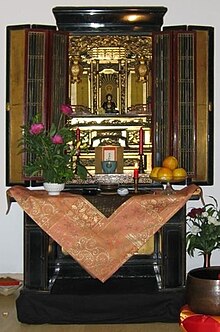Butsudan


A butsudan (佛壇 or 仏壇) is a shrine found in religious temples and homes of Japanese and other Buddhist cultures. A butsudan is a wooden cabinet with doors that enclose and protect a religious icon, typically a statue or a mandala scroll. The doors are opened to display the icon during religious observances. A butsudan usually contains subsidiary religious items called "butsugu," such as candlesticks, incense burners, bells, and platforms for placing offerings. Some buddhist sects place "ihai", memorial tablets for deceased relatives, within or near the butsudan.
Butsudan is a Buddhist shrine ranging from many sizes usually found in temples and homes. The Butsudan is a Japanese word that means Buddha's (butsu) House (dan)." The shrine is placed in the temple or home as a place of worship to the Buddha, the Law of the Universe, etc. Scrolls (honzon) or statues are placed in the butsudan and prayed to morning and evening. Zen Buddhists also meditate before it.
The original design for the butsudan came long before Japan itself. In India, people built altars the size of skyscrapers as an offering place to the Buddha [citation needed]. When Buddhism came to China and Korea, statues of the Buddha were placed on pedestals or platforms.
Storms blew the statues down and broke them (being so fragile)[citation needed]. This was an automatic sign of disrespect. To protect the statue of the buddha, or later scrolls, the Chinese and Koreans built walls and doors (like a closet) around it. They could then safely offer their prayers, incense, etc. to the statue or scroll without it falling and breaking.
The Japanese finally welcomed Buddhism after many years of Shintoism. They took in the religion along with the Butsudan. With many new sects being formed, the Butsudan was placed in many temples. The Japanese took the plain walls and doors and elaborately designed them. The butsudan became the focal point of every temple.
After time went on, people began having their own Butsudans installed into the home. Here they could pay respects to the Buddha, or the Law, along with the deceased. Butsudans were carried down the family line.
Today, many people no longer have time or room for their butsudan. They either give it away or discard them completely. Family butsudans are thrown away after hundreds of years of survival. Yet, it still remains the focal part of Japanese, and now international, Buddhist practice.
On the Butsudan is located a statue of the Buddha or a deity. A scroll with writing or pictures of the Buddha can be found in the highest and central point. Water and food (usually fruits or rice) is served beneath the statue or scroll. An incense burner is also found beneath the statue and in the center. Candles and flowers or evergreens are found surrounding the incense burners. Below that can be found the Buddhist bell rung during recitation of prayers.
In some Buddhist sects, such as Jodo Shinshu, have tablets with the names of deceased carved within. Other Buddhist sects, usually do not have these. Other things can be found such as samurai swords, pictures of deceased, etc.
